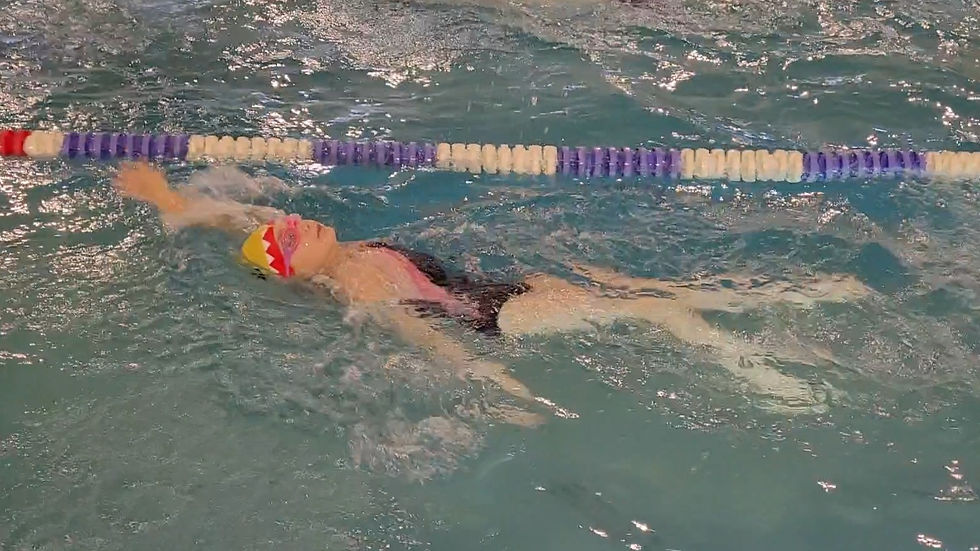Growing with Water: How Swimming Supports Healthy Development of Children
- swimmattsk
- Mar 8, 2024
- 9 min read
Updated: Mar 29, 2024
#healthyactivityforchildren #physicaldevelopmentofchildren #mentaldevelopmentofchildren #supportinghealthychilddevelopment #childhoodactivity #childrenswimming #wateractivity #swimminginBratislava #compensatoryswimming #swimmingasasupplementalsport #supplementalsport #compensation #joyofwater #exercisinginwater #drylandpreparation
In the past, parents mostly approached me with a request to teach their children how to swim properly, but nowadays, more and more parents ask for the use of aquatic environments for rehabilitation in order to guide the proper development of their children.

In this blog about compensatory swimming, I will not focus on theory. I have already written about it in several posts:
2nd part - Compensatory swimming - blog
3rd part - Compensatory swimming after injury - blog
I am focusing on practical examples from the training of children - specifically five girls who do not engage intensively in any sport (meaning 4 or more times a week), but their parents have chosen swimming to support their healthy development or as compensation for existing developmental issues.
Times are demanding, and parents have realized that it is essential to timely and appropriately compensate for the high demands of the educational process, digital age, social pressures, and sedentary lifestyle of children, in order to prevent irreversible or hard-to-treat negative physical and mental changes in adolescence and early adulthood. Therefore, I initially incorporate dryland preparation and compensatory swimming exercises into the training of children, which establish a solid foundation for swimming styles training.
The entire training process is designed to support the physical and mental development of children, improve breathing mechanics, strengthen their self-confidence, independence, discipline, as well as overall physical and mental resilience.
Dryland preparation
At the beginning of this chapter, we will look at the importance of dryland preparation in preparing children for swimming training.
Dryland preparation involves the use of various sports equipment such as expanders, sticks, medicine balls, as well as exercises using one's own body weight and coordination exercises.
These elements are crucial for developing muscle strength, flexibility, and coordination, which are essential later in the pool for mastering effective swimming technique. They are part of the warm-up routine before actual swimming. I demonstrate all exercises to the children and, in an appropriate manner based on their age and maturity, explain why these exercises are important in training and how they will help them progress.
Examples from the training with Leila (13y) and Hanka (7y):
These are exercises for developing overall body mobility and functional strength, compensatory exercises - for example, exercises to prevent the development of pathological flat feet, exercises to support mental resilience, work with emotions, and imagination of body movement.
I incorporate exercises from yoga (more about How Ashtanga yoga has influenced me - blog), functional training (more about functional training), and exercises with a sticks (more about sticks training). I select the types of exercises, difficulty, and intensity very carefully, taking into account the child's age and physical and mental readiness.
During the dryland warm-up, the girls are guided to understand the changes in their own bodies due to growth, or potential specialization in another sport they pursue in their free time.
It usually takes some time for them to understand the preparation, but once they feel the benefits in the pool, their deeper interest in the structure of training and the content of exercises always becomes evident.
By practicing these skills, they take home knowledge that they can apply outside of our training sessions. Applying training habits to their lives outside the pool has a positive impact on their health and fosters independence. You can find more about how children build confidence through movement in this blog.
Swimming preparation
In this chapter, we will focus on the essentials of swimming and swimming coordination exercises - specifically variations of backstroke with arms together exercise (more information about this exercise can also be found in the compensatory swimming blog). We will explore various examples of water exercises tailored to the individual needs and abilities of children. These examples will help you better understand how swimming preparation positively influences the development of swimming abilities in children and prepares them for mastering specific swimming techniques.
Safety always comes first. Therefore, precise dryland and in-water preparation is a necessary prerequisite before actual practice of swimming technique.
In each video, you will find a description of the specific exercise demonstrated by the swimmer. Additionally, I am providing a description of the training process through which the girls are progressing. The speed of progress always depends on physical and mental maturity, as well as the number of training units per week.
Zaira, 10 years old
Leisure sport: Recreational horseback riding
Adaptation/deformation processes: None
Training goal: Mastering swimming techniques for safe movement on and under the water, proper guidance of development, physical conditioning, coordination, mental resilience, emotional work, developing imagination of body movement, fostering healthy self-confidence, and promoting independence
Number of training sessions per week: 1
Time required to master compensatory backstroke with arms together technique: 9 months
In the video below, Zaira demonstrates the technical or swimming essentials that all swimmers had to have mastered before we began focusing on training, specifically for the backstroke with arms together technique mastering.
She demonstrates the technique of the backstroke kick with her arms raised on her back and the technique of the freestyle kick with her arms tucked in on her stomach. In both cases, the swimmer performs intermittent kicking to test her own abilities, to see if she can stop at the surface without complications, and subsequently, if she can initiate movement again using only her legs without complications. After performing this check, she executes a combined swim of both positions—smoothly alternating between back and stomach positions, feeling no complications, and maintaining control over everything.
Here is a demonstation of backstroke with arms together technique:
click on pic for video streaming
First part - backstroke with arms together with head above and below the surface with backstroke kick
Second part - backstroke with arms together with head above and below the surface without backstroke kick
Zaira managed the training process with relative ease. Initially, her main obstacle to progress was her inability to control her emotions, which was appropriate for her age and level of mental development. Emotion regulation required time, so we initially adapted the training to accommodate this need. Gradually, she overcame this challenge and became an independent individual who knows exactly what she wants and what she is capable of. Currently, we are improving her freestyle technique.
Hanka, 7 years old
Leisure sport: Previously athletics, currently rock climbing
Adaptation/deformation processes: None
Training goal: Mastering swimming techniques for safe movement on and under the water, proper guidance of development, physical conditioning, coordination, mental resilience, emotional work, developing imagination of body movement, fostering healthy self-confidence, promoting independence, acquiring swimming skills as a prerequisite for kayaking
Number of training sessions per week: 1
Time required to master compensatory backstroke with arms together technique: 6 months
click on pic for video streaming
backstroke with arms together with head above water in combination with breaststroke kick
backstroke with arms together with head above and below water in combination with backstroke kick
backstroke with arms together with head submersion without backstroke kick
backstroke with arms together with head submersion and two arm pulls followed by resurfacing in combination with backstroke kick
Hanka's training process from the beginning to the present has been smooth. Given her rich sports history and a well-tuned mindset, she quickly masters new movements on dry land as well as in the water. She has full control over her emotions and can completely focus on the present moment. Her desire to learn kayaking is a great motivation. Her parents have set a condition that she must first learn to safely handle herself in the water before beginning kayaking training.
Hanka clearly follows her goal and strives to achieve maximum progress with a minimal number of training sessions per week, which she successfully accomplishes. Currently, we are focusing on perfecting the breaststroke technique.
Leila, 13 years old
Leisure sport: Recreational horseback riding
Adaptation/deformation processes: Due to rapid growth, the doctor recommended that she not stress her lower limbs due to pain in both knees; further analysis revealed fallen arches in her feet
Goal: Mastering swimming techniques for safe movement on and under the water, proper guidance of development - strengthening the lower limbs in the aquatic environment and compensating for fallen arches, physical conditioning, coordination, mental resilience, emotional work, developing imagination of body movement, fostering healthy self-confidence, promoting independence, scoliosis prevention
Number of training sessions per week: 1
Time required to master the compensatory backstroke with arms together technique: 9 months
click on pic for video streaming
First part - backstroke with arms together without submerging the head without backstroke kick
Second part - backstroke with arms together with head submersion without backstroke kick
Leila overcame a challenging start on her journey to swimming. Due to her rapid growth, her body was not initially prepared for the aquatic environment, but through perseverance, she successfully mastered various swimming techniques. Initially, she struggled with the speed of movement and fear in the water, but through training and her own courage, she overcame the mental block. This experience strengthened her and sparked a desire for new information, allowing her to progress more quickly. In the water, she now behaves in a much more dynamic way, with more intense movements.
Leila also faced unexpected complications - growth-related knee problems that significantly affected her training regimen. Dryland preparation was also complicated due to flat feet. However, we gradually adjusted her dryland and in-water training to safely support and load her legs, promoting their proper development. Currently, we are focusing on perfecting Leila's freestyle technique.
Eliska, 9 years old
Leisure sport: Formerly gymnastics, currently recreational horseback riding
Adaptation/deformation processes: Hyperlordosis in the lumbar spine area
Goal: Mastering swimming techniques for safe movement on and under the water, proper guidance of development - compensating for hyperlordosis, physical conditioning, coordination, mental resilience, emotional work, developing imagination of body movement, fostering healthy self-confidence, promoting independence
Number of training sessions per week: 1
Time required to master the compensatory backstroke with arms together technique: 10 months
click on pic for video streaming
backstroke with arms together with/without submerging the head without backstroke kick
Eliska used dryland preparation to gain a deeper understanding of the impact of hyperlordosis on her health. During diverse warm-up exercises, she slowly learned to perceive the degree of curvature of the spine, actively engaging in the safe execution of her movements. At nine years old, she is at a stage where she must be able to self-monitor and prevent excessive movements of her spine, which had previously become "natural" for her.
In the water, Eliska moves with ease and has full control over her emotions, but her path to smoother swimming is not without obstacles. Her precise focus and complex thinking, which would surprise many at her age, paradoxically hinder her from going with the flow, limiting herself with unnecessary control. Training for her represents more than just physical preparation – it is a journey to understand the balance between conscious control and spontaneity of movement. I am trying to show her that sometimes it is safer and more effective to let the body work on its own, without constant intervention of the mind. Eliska faces the challenge of learning to trust her body and her own abilities, a process that requires time and patience. Her determination and attention to detail will take on a new dimension when she dares to let her body reach higher speeds without the need to consciously control it. I believe that through training and gradual improvement of the butterfly stroke technique and subsequently freestyle, Eliska will touch new horizons and fully discover her potential.
Klarka, 8 years old
Leisure sport: Formerly gymnastics, currently recreational horseback riding
Adaptation/deformation processes: None
Goal: Mastering swimming techniques for safe movement on and under the water, proper guidance of development, physical conditioning, coordination, mental resilience, emotional work, developing imagination of body movement, fostering healthy self-confidence, promoting independence
Number of training sessions per week: 1
Time required to master the compensatory backstroke with arms together technique: 10 months
click on pic for video streaming
backstroke with arms together with/without submerging the head without backstroke kick
Klarka is a force of nature who, in contrast to Eliska, reacts instantly and without restraint in the aquatic world. Her swimming is turbulent, and emotions prevail when things don't go as she imagines. This is precisely why training in the water is crucial for her. It's not just for improving technique, but also for learning how to control her emotions and use them to her advantage in her performance (more on understanding emotions in swimming in this blog).
Klarka's movements are full of energy and courage; she is undeterred by pain or demanding work. Her confidence is unusually high, which, at her age, can be a double-edged sword. However, I believe that with gaining control over her emotions and understanding how to use them correctly in critical moments, Klarka will achieve great things. Currently, we are working on perfecting Klarka's backstroke technique and will later move on to freestyle technique - the crawl.
Swimming Technique Training
Thanks to the support of proper physical and mental development through both dryland and swimming preparation, we were able to move on to the actual training of the backstroke technique. The examples of selected girls vividly illustrate what they have learned, the progress they have made - how they improve in controlling their bodies, in their swimming performance - and how their swimming technique differs based on their physical and mental maturity.
Zaira, 10 years old
click on pic for video streaming
Hanka, 7 years old
click on pic for video streaming
Leila, 13 years old
click on pic for video streaming
Eliska, 9 years old
click on pic for video streaming
Klarka, 8 years old
click on pic for video streaming
In conclusion...
In conclusion, we can state that thorough preparation and training not only help girls improve their swimming abilities but also develop their physical and mental resilience. It also allows them to better understand their bodies and emotions, making them more confident and independent.
The diversity of movement expression in the aquatic environment and mastering various swimming techniques and exercises enable children to continuously progress, develop, and strengthen their physical and mental abilities. It also prepares them for future life challenges.
If you like my training system, don't hesitate to contact me and enroll your child for the first trial session. I look forward to it!
You can also find more information about children's swimming training HERE.

















































